The decision to make the Calvados (Omaha & Gold) the principal place of the allied landing should have condemned the beautiful city of Bayeux to death.
As a modern visitor, you might imagine that you'd see a new city in place of the ruins of Bayeux, a city with great arteries intersecting at right angles, lined with modern constructions and focusing its perspectives on a considerably restored cathedral, like the ones in Caen, Le Havre, Rouen, Lisieux, or Saint Lo, to name just a few… but, fortunately, that is not so!
The events of June 1944 had the sole consequence of creating a magnificent peripheral boulevard built by the English troops, a boulevard that spared the city from devastation: The famous By Pass.
Thanks to its preservation—which is so astonishing it might be considered a miracle, particularly when you see cities such Caen, Lisieux, Le Havre, Cherbourg, Saint Lo, Montebourg, and Valognes in ruins—the city of Bayeux tells a story all its own. The sheer number of original buildings and residences as well as the richness of detail within recalls the events of the city's life, its epochs of prosperity as well as its wounds.
Art and history combine to express the city's soul.
It is a very old city, born more than 2000 years ago of Gallic and Roman parents. Its official birth certificate is entered in the register of history around the year 60 by Pliny the Elder; but it had already been Roman for a century.
Anecdote: Gaius Plinius Secundus, better known as Pliny the Elder, was a Roman author, naturalist, and natural philosopher, as well as naval and army commander of the early Roman Empire, and personal friend of the emperor Vespasian
The memory of the original forests of oak and beech is still found in the barrels of columns and the stone foliage of the cathedral.
The Roman occupation is fixed forever underground in the stone foundation located in the heart of the city. For example, If you park at the “Place aux Pommes” near the Tourism Office, know that you're parking just above Roman vestiges!
The sea is not far away (10 minutes drive) and its presence is evident. The sea brought the barbarous Saxons who established its colonies to the shores of Bayeux as well as the cruel Norman conquerors who seized the earth and repaid it, and in 1944, the sea washed the city's liberators ashore.
Today, Bayeux welcomes its amiable crowds of international tourists— an average of 1 million per year.
As for France, Bayeux did not escape the throes of the centuries of the Great Invasions, whose duration and weight are often underestimated in spite of the precise dates.
From the second and final Saxon invasion to the installation of the Normans, we have very few memories. Apart from the facts of the Christian settlement, the architecture of Bayeux, in any case, has retained only the vestiges of the layers of ashes marking pillages and fires, here and there hasty treasures buried, and some fortifications to the foundations of stone and bricks.
This silence and these tenets would seem to you thick and intolerable if, in the light of a stained-glass window, some figures of saints, haloed with legends but asserted by the solid pillars of the sanctuaries, had reached you; and behind them you can easily imagine hearing, in spite of everything, people singing, perhaps praising the Lord.
The Aure River, more important in the time of the Bajocasses, fixed the site of Bayeux. In the Late Empire it took the name of the Celtic tribe who lived here: the Bodiocassi, Latinized in Bajocassi, Bajocasses.
The importance of the Cathedral in relation to the city establishes the educative and tutelary role of the Church and the Bishopric. Its beauty proclaims the sincerity and vigor of the faith received at baptism around the time of the 4th century.

Notre Dame de Bayeux cathedral
None of the many wooden houses built by the Normans, according to their Nordic customs, still stand today. When there was so much good stone available, it made no sense to pile up highly flammable houses in one small space, one on top of the other. But when the invaders finally were conquered by their own conquest, they bequeathed to posterity—transiting through many perils—the most solid and most fragile treasures of the city: the always cheerful cathedral and the "Telle du Conquest", the precious Bayeux Tapestry. This treasure brings to the knowledge of the ages the great exploit of youth: the conquest of England.
The Middle Ages left more traces. Remains of ramparts and ditches, Romanesque or Gothic cellars, and some wooden houses will allow you to imagine what it might have been like during the reign of Charles V, around 1378.
Close your eyes and visualize the feudal city, surrounded by ditches, heightened by ramparts with towers, and machicolations, dominated by the magnificence of the Mother-Church, punctuated with bells, towers and weathercocks, colored with whitewashes and banners deployed, sounded by the chimes of the seventeen parishes, to which were added the bells of the monks, and the nuns, whose bells were still more insistent. What a sight (and sound) it must have been!
The abundance of small manor houses, some sixty or so, with a tower sometimes reinforced by a turret, shows that the period extending from the end of the Hundred Years' War (Formigny, 1450) to the beginning of the Religious Wars (1562) was, in spite of the ravaging pestilence tearing through the region, a period of prosperity.
These small hotels are a little dilapidated, but the safeguarding plan of the city hall of Bayeux made it possible to restore as many as possible and, while respecting their cachet, to make them more pleasant, for those who wished to look at them as well as those who wanted to stay there. They provoke the rapture of the tourist who has the impression, having ventured to the bottom of a court or a dead end, of making a personal discovery. Will you be the next one?
As in France, the wars of Religion have made irreparable voids, especially in religious statuary, objects of worship, and furniture. The Rebellion also weighed upon the people. Very little was built. The five main residences that remain of this period are very interesting testimonies of architecture with what I call a little musketeer touch!
The greatest architectural period of Bayeux began under Louis XV and flourished towards the end of his reign, when in 1771, having suppressed the Parliaments, the King fixed the "Grand Council of Normandy" at Bayeux. The influx of nobility of dress attracted squires who all wanted to have their own little castle in town too. A fever of construction seized Bayeux, which became an Eldorado. Forty great hotels emerged in eighteen years, definitively marking the city by the Louis XVI period, namely the grace of the interiors in the Marie Antoinette style.
1st anecdote: Marie Antoinette (2 November 1755 – 16 October 1793), was the last Queen of France prior to the French Revolution. On 10 August 1792, the attack on the Tuileries forced the royal family to take refuge at the Assembly, and on 13 August the family was imprisoned in the Temple. On 21 September 1792, the monarchy was abolished. After a two-day trial begun on 14 October 1793, Marie Antoinette was convicted by the Revolutionary Tribunal of high treason, and executed by guillotine on “Place de la Révolution” (Place Concorde today) on 16 October 1793.
2nd anecdote: Marie Antoinette was imprisoned at the Conciergerie. The Conciergerie became one of the principal places of detention during the French Revolution, with the installation of the Revolutionary Court. Its most famous prisoner was Marie Antoinette. During the Restoration, a commemorative chapel was erected on the site of her cell. Normandy American Heroes strongly recommend you do take the time to visit it; a new interpretive approach has been put in place, and it's well worthwhile to discover!
3rd anecdote: Do not miss the unique Saint Chapelle, a gem of Gothic style next to the Conciergerie. Built in seven years, the Sainte Chapelle was intended to house precious Christian relics (including Christ's crown of thorns) acquired by Saint Louis. You will have the opportunity to admire the Stunning stained glass. Arranged across 15 windows, each 15 meters high, the stained glass panes depict 1,113 scenes from the Old and New Testaments recounting the history of the world until the arrival of the relics in Paris. Last but not least, if you book in advance, you will have the privilege to listen to a classical concert such as the Four Seasons of Vivaldi!
However, even in this period of effervescence, one respects the rights of each: the acquired property is inviolable, sacred. No neighborhoods systematically rebuilt, no houses completely shaved and rebuilt. The styles of constructions are juxtaposed in disorder. This is notorious in the deep cellars which connect as best they can to the house they serve. On the other hand, the abundance of green spaces, parks and gardens jealously enclosed in the properties proves that the rural soul of the Bessin has placed its seal on the small capital. Note: We invite you to browse www.instantstreetview.com to see for yourself!
Bayeux is therefore also a hidden city with concealed patios. If a magician with a wave of a wand returned the properties or if the Bajocasses - something so unlikely! - opened all the large doors of their mansion, or courtyard, French gardens or parks, massifs of rhododendrons and hydrangeas would unfold and, contrasting with the severity of the walls, exhale their sweetness in happy counterpart of the monotony of the rainy days.
The Gallic city
The name of the river that crosses Bayeux, "l'Aure" comes from the Celtic "Ar" which means "river". On the alluvial quarters of the Aure, in the midst of the meadows encircled by the forests, a large Gallic tribe, the Bajocasses, settled. It found there everything necessary to live and trade: stone, wood, hunting, pasture and fishing. The first houses of Bayeux were thus those round huts, open in the middle for the smoke, which the Gallic called "Attegia" in their language.
We invite you to visit the Museum of Art & History “Baron Gérard” housed in the Bishop’s palace (11th – 18th century) as it offers a journey through the history of European art, from archaeology to Modern Art. You will discover archaeological and ethnographical pieces, paintings, sculptures, engravings, drawings, photographs, porcelain and the famous Bayeux lace.
The Roman city
After the Roman conquest, Bayeux is one of the twenty three cities of the Viducasse territory, under the administration of Arae Genuae, today named “Vieux la Romaine”, a small town south of Caen.
We recommend that you visit the Roman vestiges. Just imagine! This small village used to be the capital town of a Roman territory between the 1st & 5th century A.D.! The Tutela Goddess will invite you to explore some of the sites she protects and let you discover what life was like during the Roman times.
1st anecdote: Tutela was the ancient Roman concept of "guardianship", conceived of as a goddess in the Imperial period, and from the earliest period as a functional role that various tutelary deities might play, particularly Juno. Tutela had particular applications in Roman law.
2nd anecdote: Juno (Juno beach, Dday landing beach for the Canadians) is an ancient Roman goddess, the protector and special counselor of the state. She is a daughter of Saturn and sister (but also the wife) of the chief god Jupiter and the mother of Mars and Vulcan. Juno also looked after the women of Rome
For 400 years, the Romans shaped the physiognomy of Bayeux and the region: camps, often paved roads, aqueducts, administrative or leisure buildings, temples.
The market with its relays of horses, its inn and taverns already animates the current place Saint Patrice: every Saturday morning one of the most beautiful markets of Calvados is held there.
Inevitably an altar was erected in Rome for the Emperor Augustus. In order to flatter imperial power, the city of the Bajocasses temporarily assumed the Gallo-Roman name "Augustodurum", the citadel of Augustus. Military stones bearing this name are preserved in the Baron Gérard Museum.
The Saxon city
In the year 276, a first Saxon invasion ruined Bayeux & Vieux la Romaine. This last capital did not rise: Bayeux took its place and prerogatives, and reigned between the rivers of the Orne and the Vire and from the sea to the city of Sées.
After having troubled the coasts, the Saxons returned in force towards the end of the 4th century. Bayeux was devastated, burnt down, some of the inhabitants massacred. The invaders then settled for several centuries and formed an autonomous territory. The language was Saxon. There are many Gallo-Roman camps centered on the road from Bayeux to “Douvres-la-Délivrande” destined for the defense against the marine invaders.
Anecdote: Near Port-en-Bessin, the Mont Castel is far from having given up all its secrets, from the oppidum (an ancient Celtic fortified town) of the Bronze Age to the Roman camp of the Gallic war.
Then life resumed its rights: the fertility of the ground harnessed the enemies to the same tasks and the same fights against new thieves. The women did the rest...! As for the Franks, (the free people = France) they got along quite well with the Gallo-Romano-Saxons.
In 578, Gregory of Tours mentions the Saxons of Bayeux. It is more than probable that it was towards this country that Charlemagne deported the Saxon colonies. Charles the Bald, in his Capitular of Senlis, ordered his commissioners, in 853, to visit the Cotentin, the Bessin and the “Otlinga Saxonia”.
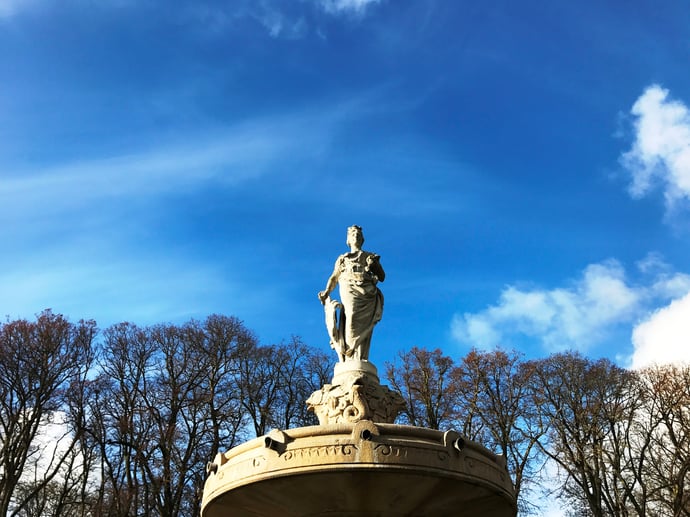
Poppa, spouse of the 1st Duke of Normandy
The Norman city - “A furore Normannorum libera nos domine”!
Of the ferocity of the Normans, deliver us, O Lord! (Litany of Saints)
Despite the late hour of the night the watchmen do not sleep. Besides, who sleeps in the city in excitement? From the top of the ramparts where they came and went, men and women were agitated, watching the spectacle lit by the Normans, commenting on it, trying to determine the locations of the fires.
What's the point? They burn everything: crops, straw, houses hastily rebuilt with beams already burnt down! Did they not, a few years earlier, even massacre the Bishop Baltfridus? Everyone knows what awaits them if they succeed in taking the city: for the old misery, for men of age death, for women, worse… for the lucky survivors, a change of life, language, morals, enrollment.
But this night, the rage of having failed several times before the ramparts only fueled their hatred. Suddenly, by surprise, they rush to the same point. The Vikings climb the wall, the prestige of their cruelty does the rest. The fate of the inhabitants is at the mercy of the glance or the mood of the victorious carnivorous. We shout, we lay low, we are burned down.
In the governor's house, the guards fled, the faithful servants being killed as if they were playing. Poppa, the daughter of Count Beranger has already fainted, just to hear them come. But this prey is taboo, reserved to share the bed of Chief Hrolf (Rollo)!
Anecdote: Rollo (c. 846 – c. 930 AD) was a Viking who became the first ruler of Normandy. He is sometimes called the 1st Duke of Normandy. Rollo emerged as the outstanding personality among the Norsemen who had secured a permanent foothold on Frankish soil in the valley of the lower Seine. Rollo is the great-great-great-grandfather of William the Conqueror, or William I King of England buried at the cathedral of Rouen.
Honor and pleasure for him, respect for her. Rollo converted will later on marry Poppa. It is in this savagery that the birth in 905 of a son “Guillaume Longue-Epée” makes Bayeux the cradle of the dynasty that will illustrate William the Conqueror, also bastard, but more peacefully, with a Frenchwoman later on in time.
Anecdote: Poppa of Bayeux Christian wife and/or mistress of the Viking conqueror Rollo was the mother of William I Longsword and grandmother of Richard the Fearless, who forged the Duchy of Normandy into a great fief of medieval France. You can see her statue at what is known today as “Place Charles de Gaulle” in Bayeux.
They speak Scandinavian at Bayeux (it took a few interpreters to make themselves understood of the natives). The northern cults were practiced there and the houses were built using wood on cellars and stone foundations. A clandestine immigration which escaped the vigilance of the dukes maintained for a long time, purer than elsewhere, the Norse language, so that sometimes they sent teenagers to perfect themselves in their native language.
A few decades later we hear a Latin mixed with Norman terms. Rollo himself was baptized, and with him the invasion, a Christianity of worship was thus accepted by all, even if manners could not, for some centuries, adapt itself perfectly to the evangelical morality.
And the resurrection will have the gigantic breadth of destruction. Around 960, during the reign of Duke Richard 1st the castle was built bits by bits at the site that it will keep for 800 years, the famous “place Charles de Gaulle”.
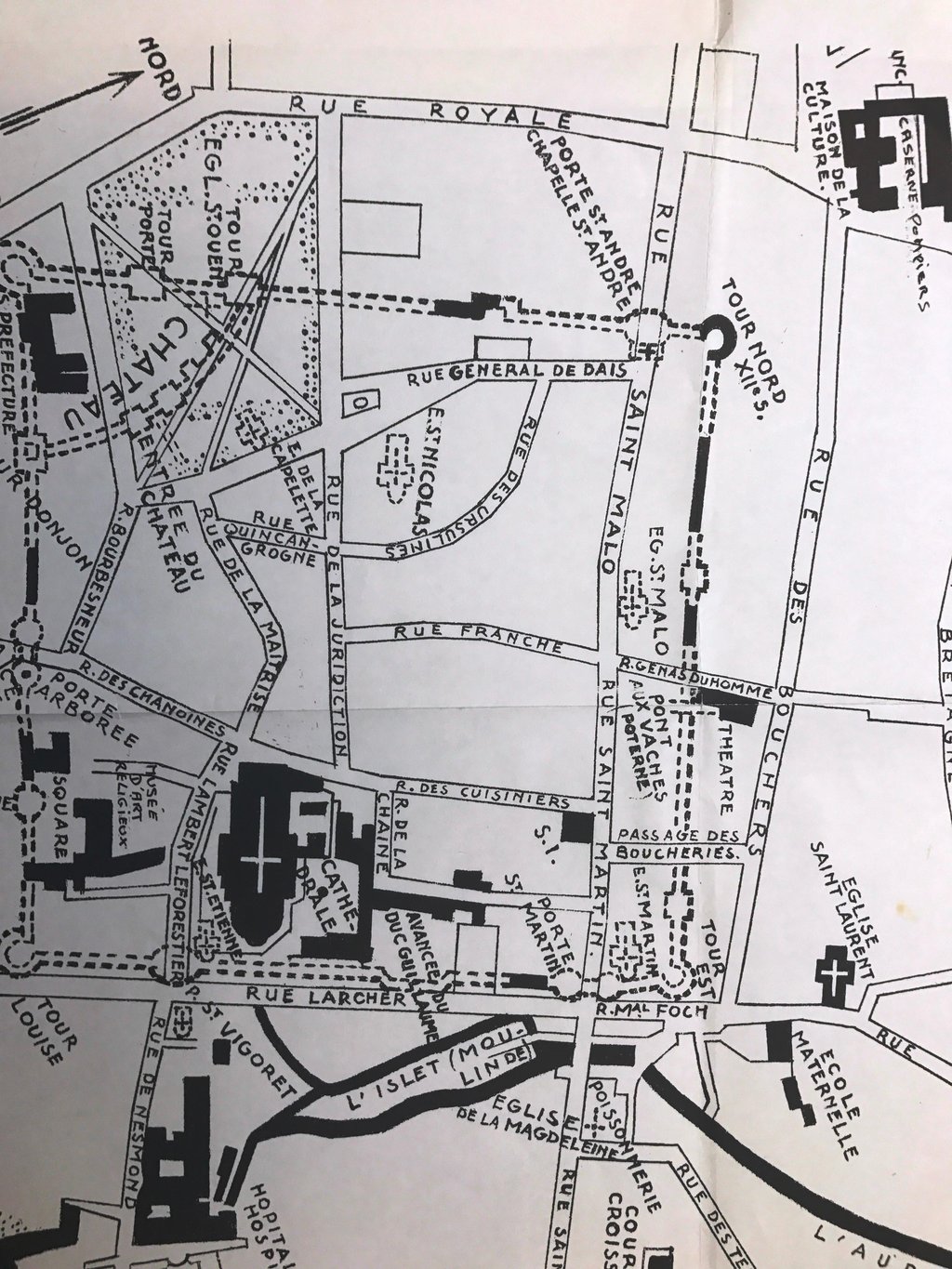
Layout of the ramparts and castle of Bayeux
Anecdote: General De Gaulle made his famous speech on June 14, 1944 "place Charles de Gaulle", pushing the allies to recognize the sovereignty of France. Bayeux thus became the capital of France until the liberation of Paris.
In 1046, Bishop Hugues begins the Cathedral: Odon de Conteville, bishop and half-brother of William the Conqueror, will finish it in his first style. It is the glorious epoch where the Duke of Normandy becomes king of England on December 25, 1066!
Anecdote: As you can imagine, I strongly recommend you discover the Tapestry of Bayeux; scene 44 depicts the meeting held between Odon de Conteville, William the Conqueror and Robert de Mortain, who after the conquest of England will be the 3rd richest nobleman there!
The Feudal city
The close attachment of Normandy to France at the time of the great kings Philippe-Auguste and Saint Louis (who visited Bayeux twice) lost its administrative importance. It must be said that at that moment the elite of the inhabitants were more attached to England by the descendants of Guillaume than to the King of France.
Philippe le Bel crossed Bayeux in 1307. He had to impose. He was already meditating the seizure of the property of the Templar’s, which took place in Bayeux in 1308; but the Order was only a simple footing at the corner of the Rue Bourbesneur and the Rue des Chanoines, a few minutes’ walk from the Cathedral. The Order headquarters was in Baugy, a parish of Planquery. Their trial, on the other hand, took place in Bayeux.
Anecdote: Feudalism is the social system that developed in Europe during the 8th century; vassals were protected by lords, in return they had to serve them in war
From that moment on the economic and financial difficulties began: the misfortunes which the Hundred Years War accentuated with its train of battles, sieges, insurrections, reprisals, famines and brigandage.
After the Cathedral, the seventeen churches and monasteries, the rehabilitation of the fortifications constituted the main collective work.
At the time of the last English invasion in 1417, the city of Bayeux attempted to support a siege against King Henry V, but it lasted only from 9 to 19 September. Let’s not forget that the other cities capitulated too! The vassals of the lord de Campigny defended the ramparts towards the “Porte Arborée”; the vassals of the bishop from there to the “Porte Saint-Vigoret”. The English were dissatisfied with this resistance and many people had to go into exile or preferred to do so. Their properties were confiscated. This gave a lot of trouble to justice when things got back to normal.
The bishops of England effectively exerted pressure on Bishop Jean Langret to recognize Henry V as the King. But he had to retract himself because he will be mortally wounded on 12 June 1418 in Paris during the massacre of the Armagnacs (supporters of the Dauphin).
Anecdote: Dauphin, formerly, the eldest son of the King of France and direct heir to the throne
After the invasions of the Normans, the wooden houses had proliferated and the fires too! In 1650, the aldermen forbade townspeople to continue building with wood. It was reasonable, since the stone was not in shortage; we had built the Tower of London and Westminster Abbey with the stone of Caen! It was decidedly prudent— in 1777 a whole block of these old houses burned to ashes in the “Rue du Goulet”. Bayeux is therefore deprived of these marvelous abodes which enhanced its charm. One can find them in cities like Pont-l'Evêque, Lisieux, Honfleur, to name a few.
The fourteenth century fortunately left us two large half-timbered houses and the fifteenth left two others with carved woods. One is located 12 rue des Cuisiniers, close to the home of my Mother, whose house dates back to the 17th century with two incredible stone staircases.
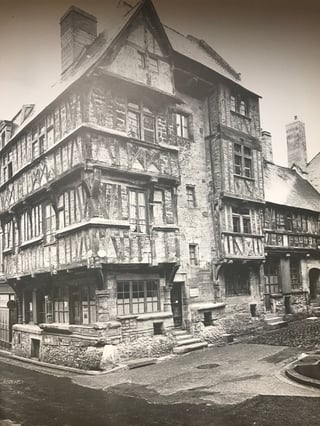
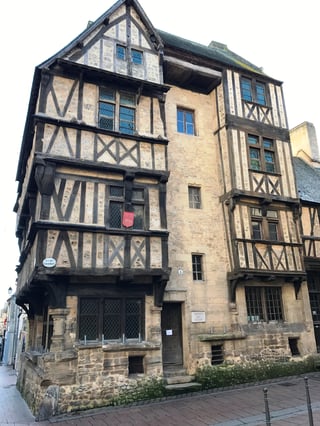
One of the wooden houses still standing in Bayeux (taken in 1930 & 2016)
The “Argouges” family
One of the most famous family names of Bayeux is without contest the “Argouges”. At the time of the war between William’s sons (1105-1106), Robert d'Argouges appeared, winning a singular, official and spectacular fight on behalf of the Duke Robert Courteheuse against King Henri 1st of Beauclerc. The latter was not an honorable man; he was of bad faith. He exiled Robert, whom we find combating in Sicily with a soon to be famous cry of war "to faith."
Pronounced by the Norman, this motto became "à la fée" (to the fairy)! And the d'Argouges ended by painting on their coat of arms a naked woman with long hair holding a mirror in her right hand. Hence the legend of the Fairy of Argouges narrated so well, but differently, by the owner of the Manor of Argouges where we take our guests for a candle light visit followed by a medieval cocktail dinner!
Hereafter a brief summary of the Fairy of Argouges story…
A rich lord lives a wonderful dream. Protected by a fairy, he ended up marrying her and their happiness will last as long as it will not be broken by the word "death" pronounced before her. One day, when the bride dwelt on her dress, d'Argouges grew impatient and finally cried out: "You are so long in preparing yourself that you should be chosen to go and seek death!" The bride-fairy disappeared immediately, leaving only the imprint of her foot on a stone.

"Arbre de la liberté" planted in 1797 next to the Cathedral of Bayeux
Hotel d’Argouges – Normandy American Heroes partner for our guests
According to the writings of Desdouits, the origin of the hotel goes back to the days of King Henry IV. It would have been built by a lord of Argouges.
Jacques Gilbert, lord of the River Vaucelles and other places, acquired it in 1759. It was an era of prosperity for Bayeux and he hastened to modify his house to bring it up to date. It is well known that fashion demands the fortunes of life as they hasten to distance themselves from the period which preceded them, in this case the 18th century.
Corentin Conseil, mayor of Bayeux from 1812, lived in this house and received there, on April 15, 1814, a son of the future Charles X, the Duke Jacques de Berry who was assassinated in 1820 by Louvel.
1st anecdote: Louis Pierre Louvel, born on October 7, 1783 in Versailles and guillotined on June 7, 1820, “place de Grève” in Paris, was a Bonaparte’s French saddler who entered history by assassinating the Duke of Berry in Paris on the night of 13 to 14 February 1820. He was sentenced to death on 6 June on what is known today as the Place de l'Hôtel de Ville not far from the renowned Notre Dame de Paris.
2nd anecdote: The Opera Garnier was founded in 1669 by Louis XIV as the “Académie d'Opéra”, and shortly thereafter was placed under the leadership of Jean-Baptiste Lully and officially renamed the Académie Royale de Musique. Gaston Leroux, author of the renowned "Phantom of the Opera", was inspired by the famous underground lake and river Batelière!
Corentin Conseil seriously worried during the “Cent Jours" (Hundred Days where Napoleon briefly returned to power). As a good citizen of Bayeux, he had to show certain wisdom of adjustment! Had not King Louis XVI received a warm reception in front of the very door of this hotel in 1786! Had not the "Rue Royale" been opened to him? Then, in 1812, "Vive l'Empereur!" was shouted on this "Place de l'Egalité". Same welcome for the Empress in 1813, then for Louis-Philippe, Napoleon III etc…
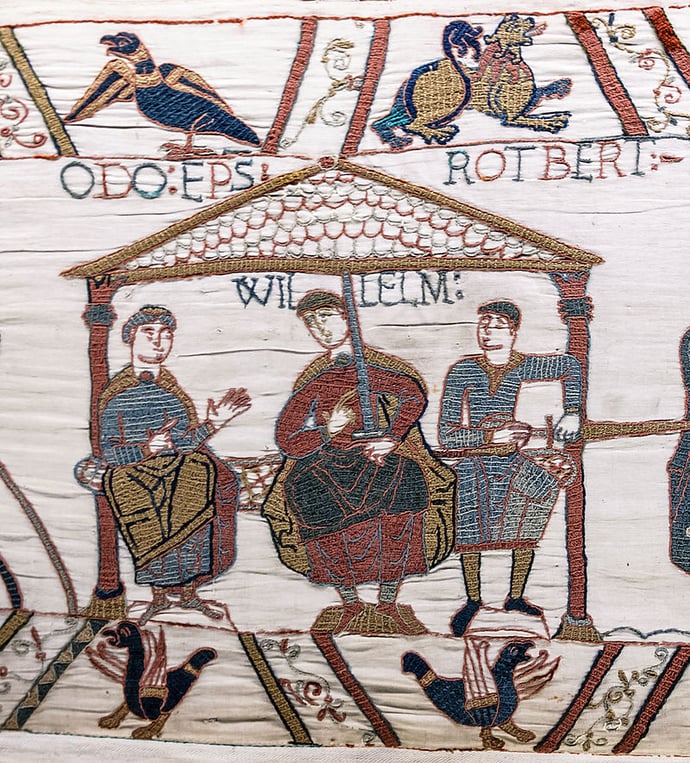
Tapestry of Bayeux scene 44 Odon de Conteville
The illustrious hosts of Bayeux
Rollo (host not invited nor welcomed!) (846 – 930 AD) was a Viking who became the first ruler of Normandy, a region of<


















